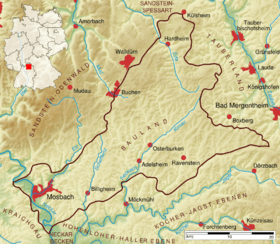Bauland
The Bauland is a Gäu landscape in the northeast of the German state of Baden-Württemberg. It is a natural region within the Neckar and Tauber Gäu Plateaus (major unit 12) in the South German Scarplands.

Natural region no. 128 (outlined in brown)
Location
The Bauland is a Gäu landscape in the northeast of the German state of Baden-Württemberg. It is a natural region within the Neckar and Tauber Gäu Plateaus (major unit 12) in the South German Scarplands. It lies between the Odenwald forest and the Tauber, Jagst and Neckar rivers within the counties of Main-Tauber-Kreis and Neckar-Odenwald-Kreis. It also reaches into Hohenlohekreis and the county of Heilbronn. The Bauland is no. 128 in the classification system of the Handbook of Natural Region Divisions of Germany.[1]
Etymology
The name Bauland goes back to the word Ponland which meant a "strip of land in which beans are cultivated" (from the Middle High German pône).[2] The Bauland is colloquially known as Baden Siberia (Badisch Sibirien) due to its climate.[3] It is home to a form of spelt crop called Grünkern.[3]
Villages in the Bauland
- Adelsheim
- Ahorn
- Altheim
- Billigheim
- Buchen (Odenwald)
- Elztal
- Hardheim
- Höpfingen
- Külsheim
- Osterburken
- Ravenstein
- Rosenberg
- Schefflenz
- Seckach
- Walldürn
Sights
- The over 600-metre-long Eberstadt Dripstone Cave (Eberstadter Tropfsteinhöhle) which is the accessible part of the Eberstadt Cave Worlds (Eberstadter Höhlenwelten)
- Doline fields as witnesses of the karst landscape
- Upper Germanic-Rhaetian Limes
- Adelsheim: Historic old town, Bauland Local History Museum
- Osterburken: Roman Museum, Roman castra
References
- Meynen & Schmithüsen 1960.
- Peter Wiesinger (1995), E. Eichler u. a. (ed.), "Die Bedeutung der Eigennamen: Volksetymologie", Namenforschung. Ein internationales Handbuch zur Onomastik (in German), Berlin / New York: de Gruyter, pp. 463–471, retrieved 11 October 2012
- Zentrum und Provinz – die Entstehung von „Badisch Sibirien“ at www.erfatal-museum.de. Retrieved 10 Mar 2019.
Literature
- Emil Meynen and Josef Schmithüsen (editors): Handbuch der naturräumlichen Gliederung Deutschlands. Bundesanstalt für Landeskunde, Remagen/Bad Godesberg, 1953–1962 (9 issues in 8 books, updated map at 1:1,000,000 scale with major units: 1960).
External links
| Wikimedia Commons has media related to Bauland. |
- Natural region fact file Bauland (128) – LUBW (pdf, 9,9 MB)